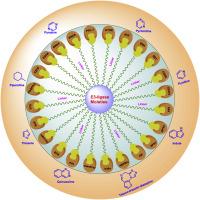当前位置:
X-MOL 学术
›
Eur. J. Med. Chem.
›
论文详情
Our official English website, www.x-mol.net, welcomes your
feedback! (Note: you will need to create a separate account there.)
Next-generation cancer therapeutics: PROTACs and the role of heterocyclic warheads in targeting resistance
European Journal of Medicinal Chemistry ( IF 6.0 ) Pub Date : 2024-11-08 , DOI: 10.1016/j.ejmech.2024.117034 Ebna Azizal Omar, R. Rajesh, Pronoy Kanti Das, Rohit Pal, Gurubasavaraja Swamy Purawarga Matada, Lalmohan Maji
European Journal of Medicinal Chemistry ( IF 6.0 ) Pub Date : 2024-11-08 , DOI: 10.1016/j.ejmech.2024.117034 Ebna Azizal Omar, R. Rajesh, Pronoy Kanti Das, Rohit Pal, Gurubasavaraja Swamy Purawarga Matada, Lalmohan Maji

|
One of the major obstacles to sustained cancer treatment effectiveness is the development of medication resistance. Current therapies that block proteins associated with cancer progression often lose their efficacy due to acquired drug resistance, which is frequently driven by mutated or overexpressed protein targets. Proteolysis-targeting chimeras (PROTACs) offer an alternative therapeutic strategy by hijacking the cell's ubiquitin-proteasome system to degrade disease-causing proteins, presenting several potential advantages. Over the past few years, PROTACs have been developed to target various cancer-related proteins, offering new treatment options for patients with previously untreatable malignancies and serving as a foundation for next-generation therapeutics. One of the notable benefits of PROTACs is their ability to overcome certain resistance mechanisms that limit the effectiveness of conventional targeted therapies, as shown in several recent studies. Additionally, research teams are investigating how PROTACs can selectively degrade mutant proteins responsible for resistance to first-line cancer therapies. In the pursuit of novel and effective treatments, this review highlights recent advancements in the development of PROTACs aimed at overcoming cancer resistance. When it comes to drug design, heterocyclic scaffolds often serve as a foundational framework, offering opportunities for modification and optimization of novel molecules. Researchers are similarly exploring various heterocyclic derivatives as “warheads” in the design of PROTACs has been instrumental in pushing the boundaries of targeted protein degradation. As warheads, these heterocyclic compounds are responsible for recognizing and binding to the target protein, which ultimately leads to its degradation via the ubiquitin-proteasome system. This study aims to provide a comprehensive overview of cutting-edge strategies in PROTAC design, offering detailed insights into key concepts and methodologies for creating effective PROTACs. Special emphasis is placed on structure-based rational design, the development of novel warheads, and their critical in influencing biological activity.
中文翻译:

下一代癌症治疗药物:PROTAC 和杂环弹头在靶向耐药性中的作用
持续癌症治疗效果的主要障碍之一是耐药性的发展。目前阻断与癌症进展相关的蛋白质的疗法通常会因获得性耐药性而失去疗效,而获得性耐药性通常是由突变或过表达的蛋白质靶标驱动的。蛋白水解靶向嵌合体 (PROTAC) 通过劫持细胞的泛素-蛋白酶体系统来降解致病蛋白,从而提供了一种替代治疗策略,具有几个潜在优势。在过去的几年里,PROTAC 已被开发用于靶向各种癌症相关蛋白,为以前无法治愈的恶性肿瘤患者提供了新的治疗选择,并作为下一代疗法的基础。PROTAC 的显着好处之一是它们能够克服某些限制传统靶向治疗有效性的耐药机制,如最近的几项研究所示。此外,研究团队正在研究 PROTAC 如何选择性降解导致对一线癌症治疗耐药的突变蛋白。在寻求新颖有效的治疗方法的过程中,本综述重点介绍了旨在克服癌症耐药性的 PROTACs 开发的最新进展。在药物设计方面,杂环支架通常作为基础框架,为新分子的修饰和优化提供机会。研究人员同样在探索各种杂环衍生物,因为 PROTAC 设计中的“弹头”有助于突破靶向蛋白质降解的界限。 作为弹头,这些杂环化合物负责识别并结合靶蛋白,最终导致其通过泛素-蛋白酶体系统降解。本研究旨在全面概述 PROTAC 设计中的前沿策略,为创建有效 PROTAC 的关键概念和方法提供详细见解。特别强调基于结构的理性设计、新型弹头的开发及其在影响生物活动方面的关键。
更新日期:2024-11-08
中文翻译:

下一代癌症治疗药物:PROTAC 和杂环弹头在靶向耐药性中的作用
持续癌症治疗效果的主要障碍之一是耐药性的发展。目前阻断与癌症进展相关的蛋白质的疗法通常会因获得性耐药性而失去疗效,而获得性耐药性通常是由突变或过表达的蛋白质靶标驱动的。蛋白水解靶向嵌合体 (PROTAC) 通过劫持细胞的泛素-蛋白酶体系统来降解致病蛋白,从而提供了一种替代治疗策略,具有几个潜在优势。在过去的几年里,PROTAC 已被开发用于靶向各种癌症相关蛋白,为以前无法治愈的恶性肿瘤患者提供了新的治疗选择,并作为下一代疗法的基础。PROTAC 的显着好处之一是它们能够克服某些限制传统靶向治疗有效性的耐药机制,如最近的几项研究所示。此外,研究团队正在研究 PROTAC 如何选择性降解导致对一线癌症治疗耐药的突变蛋白。在寻求新颖有效的治疗方法的过程中,本综述重点介绍了旨在克服癌症耐药性的 PROTACs 开发的最新进展。在药物设计方面,杂环支架通常作为基础框架,为新分子的修饰和优化提供机会。研究人员同样在探索各种杂环衍生物,因为 PROTAC 设计中的“弹头”有助于突破靶向蛋白质降解的界限。 作为弹头,这些杂环化合物负责识别并结合靶蛋白,最终导致其通过泛素-蛋白酶体系统降解。本研究旨在全面概述 PROTAC 设计中的前沿策略,为创建有效 PROTAC 的关键概念和方法提供详细见解。特别强调基于结构的理性设计、新型弹头的开发及其在影响生物活动方面的关键。


















































 京公网安备 11010802027423号
京公网安备 11010802027423号